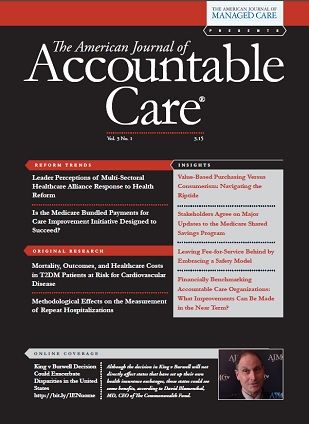- Center on Health Equity and Access
- Clinical
- Health Care Cost
- Health Care Delivery
- Insurance
- Policy
- Technology
- Value-Based Care
Insured but Not Covered-Using Clinical Nuance to Create "Smarter Deductibles"
In the wake of health insurance expansion under the Affordable Care Act (ACA), attention has focused on the impressive enrollment numbers and the substantial drop in the number of uninsured. Perhaps equally important is the discussion on how well an insurance plan meets an individual’s medical and financial needs—a testament to this is the growing focus on financial hardships among the newly insured.
High-deductible health plans (HDHPs) are one of the fastest growing coverage options; more than a quarter of all employers1 offer these types of plans—up from just 4% a decade ago. In the individual marketplace, 85% of enrollees purchased either silver or bronze HDHPs; in 2014, the deductible for a silver HDHP was nearly $30002 (individual) and $6000 (family). HDHPs are attractive because they often have a lower monthly premium. However, concerns persist that higher out-of-pocket costs may hinder the use of evidence-based services, which may be particularly salient for the economically vulnerable and those with chronic diseases. Compared with those in traditional plans, individuals with chronic diseases enrolled in HDHPs3 are more likely to go without care due to cost or experienced significant financial hardship due to medical bills.4 When individuals with chronic diseases forgo recommended services, it not only impacts their health, but may result in higher aggregate costs.5
HDHPs provide first-dollar coverage (ie, exempt from any deductible) for specific primary preventive services as mandated by the ACA. However, Internal Revenue Service (IRS) regulations preclude HDHPs coupled with a health savings account (HDHP-HSA) from covering most secondary preventive services. With the exception of some prescription medications, the IRS guidance excludes many guideline-recommended services from being deductible-exempt, many of which are established quality metrics (eg, retinal examination for diabetes).
We recently estimated6 the premium and market effects that would result from updating the IRS guidance to enable a more clinically nuanced approach based on the principles of value-based insurance design (V-BID), thereby allowing specific evidence-based, secondary preventive services to be deductible-exempt. We found that this hypothetical HSA-HDHP/VBID hybrid, referred to as a “high-value health plan” (HVHP), would increase utilization of deductible-exempt high-value services, leading to a short-term premium increase of just over 5%, compared with HDHPs that require beneficiaries to pay the entire cost of these services until the deductible is met.
Our model estimated that these novel HVHPs with “smarter” deductibles would be extremely popular options, attracting tens of millions of consumers, ranging from those in HDHPs looking for richer coverage, to those in other types of plans (eg, PPOs, HMOs) seeking a more cost-effective option. Our research demonstrated that any substantial shift from more expensive, non-HDHPs to lower cost HVHPs would lead to substantially reduced aggregate healthcare expenditures on a population level.
Consumers need to be better informed about the cost and clinical impact of their coverage. Enrollees should be able to access—with minimal financial hardship—the clinician visits, diagnostic tests, drugs, and procedures that effectively manage chronic diseases and that are increasingly used to benchmark providers.
As we expand insurance, we should remember that the ultimate goal of health transformation is to contain cost growth and improve health. Thus, regulators must provide plans with greater flexibility to permit innovative designs, such as HVHPs, that will not only enhance access to important clinical services, but will also attract new members to join plans that provide incentives to beneficiaries to be active consumers of care.REFERENCES
1. 2014 Employer Health Benefits Survey. Section eight: high-deductible health plans with savings option. Kaiser Family Foundation website. http://kff.org/report-section/ehbs-2014-section-eight-high-deductible-health-plans-with-savingsoption/. Published September 10, 2014. Accessed March 9, 2015.
2. Deductibles, out-of-pocket costs, and the Affordable Care Act. HealthPocket website. https://www.healthpocket.com/healthcare-research/infostat/2014-obamacare-deductible-out-of-pocket-costs#.VOiIQfnF98F. Published December 12, 2013. Accessed March 9, 2015.
3. Galbraith AA, Soumerai SB, Ross-Degnan D, Rosenthal MB, Gay C, Lieu TA. Delayed and forgone care for families with chronic conditions in high-deductible health plans. J Gen Intern Med. 2012;27(9):1105-1111.
4. Galbraith AA, Ross-Degnan D, Soumerai SB, Rosenthal MB, Gay C, Lieu TA. Nearly half of families in high-deductible health plans whose members have chronic conditions face substantial financial burden. Health Aff. 2011;30(2):322-331.
5. Sokol MC, McGuigan KA, Verbrugge RR, Epstein RS. Impact of medication adherence on hospitalization risk and healthcare cost. Med Care. 2005;43(6):521-530.
6. Health Savings Account Eligible High Deductible Health Plans: Updating the definition of prevention. V-BID Center website. http://vbidcenter.org/wp-content/uploads/2014/07/HDHP-white-paper_final.pdf. Published May 2014. Accessed March 9, 2015.


